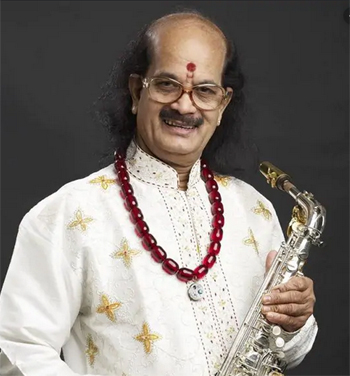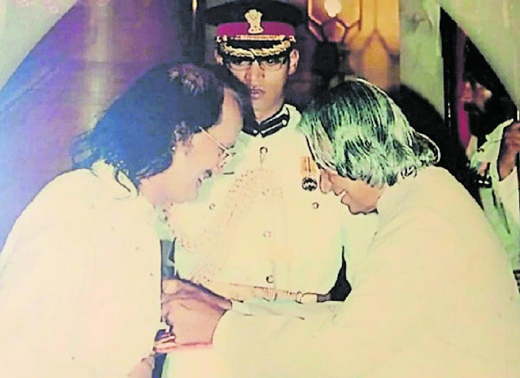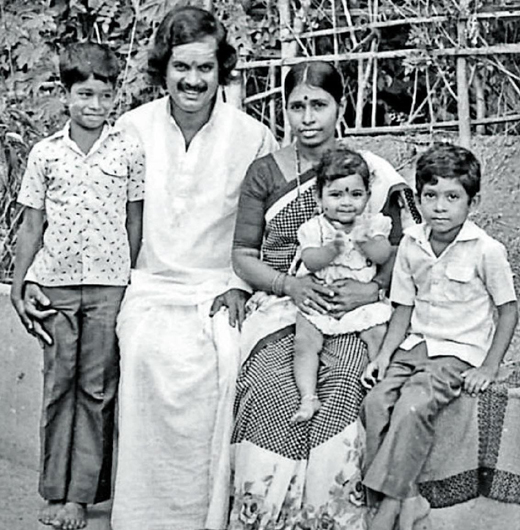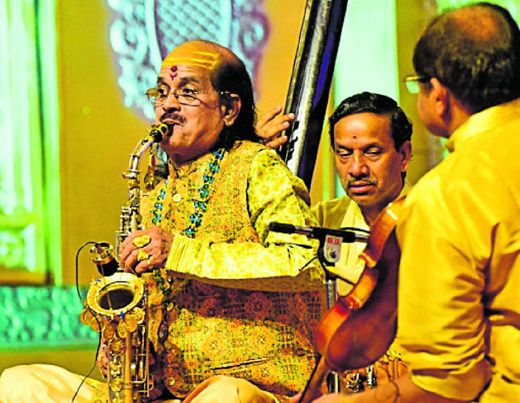
Padmashree Kadri Gopalnath made western instrument deliver Indian notes
Mangalore Today News Network
Mangaluru, Oct 12, 2019: Wests saxophone is admired for its deep throat soul churning notes, Wizard Kadri Gopalnath is a pioneer to make it deliver delicate graceful Carnatic classical notes to perfection. A feat unimaginable to the ordinary musician.


Kadri Gopalnath receives Padma Shri award from the then President A P J Abdul Kalam.

A family photo of Kadri Gopalnath.

Kadri Gopalnath performing at an event.
Mangaluru plunged into sorrow and all saw it spread world wide now - Kadri (69), passed away October 10 Thursday.
The Western instrument took the traditional Indian pipe, the nadaswaram, which he had learnt from his father Taniyappa, bu storm. It marked a shift from the booming, nasal beauty of the nadaswaram to the brassy flamboyance of the deep throat saxophone. Gopinath did not switch to any Western ape; he converted and continued to play traditional south Indian music on an instrument he had picked up after first hearing it at the Mysore palace.
A mangala vadya, the nadaswaram is played in the southern states to mark auspicious occasions such as weddings and temple festivals. Thanks to Kadri and some of his predecessors, the saxophone is now part of the mangala vadya ensemble. Over the last few decades, it has made inroads into southern classical culture. The saxophone is now heard solo or alongside the nadasawaram at temples and weddings.
That achievement is remarkable in a country hooked to film music, and familiar with the saxophone only as a sound in romantic songs. Yet, Kadri’s most popular non-film album, Raag Rang, belongs in the genre of what is generally referred to as fusion music.
He collaborated with flautist Pravin Godkhindi for the 2009 production, and no one, including Pujar, the proprietor of Sagar Music who conceptualised it, had a clue it would be a big hit.
It was the era of CDs, and the main piece, based on raga Malkauns, was inspired by two songs in the 1959 Hindi film Navrang.
While Pravin played the raga with a northern lilt, Kadri came in with the time-honoured corresponding southern raga, Hindola. The album featured talented Bengaluru musicians, such as Sangeeta Katti, Anoor Ananthakrishna Sharma, Praveen Rao and Arun, and was played at restaurants across India and abroad, and even on Air India flights.
At the peak of Kadri’s career, some admirers wished he would collaborate with Kenny G. A catchy album title could be : ’Kenny G meets Kadri G’!
That was not to be, but Kadri did get to collaborate with a New York-based jazz saxophonist with Indian roots, Rudresh Mahanthappa. Kadri took part in jazz festivals abroad, but he was happiest in his south Indian space, playing Thyagaraja and Purandara Dasa concert standards.
Kadri’s brush with the world of cinema is also well-known. He played for the Tamil film Duet, directed by K Balachandar. It is well known he played many ragas before A R Rahman, who scored the music for the film, settled on Kalyanavasantha (known in classical music through Thyagaraja’s Nadaloludai and Purandara Dasa’s Innu daya baarade). Kadri’s longish passage for the title cards, overdubbed with a cinematic chorus and drums, made him a bit of a rockstar. The passage also underlines his strength. The pace of his music is brisk rather than contemplative.
He pulls off complex gamakas (graces) with ease, and the style amazes musicians used to a more Western expression on the instrument.
Invented by Belgian musician Adolph Sax in the 1840s, the saxophone has morphed into a local instrument in the conservative world of Carnatic music. Perhaps what U Srinivas is to the mandolin, Kadri is to the saxophone.